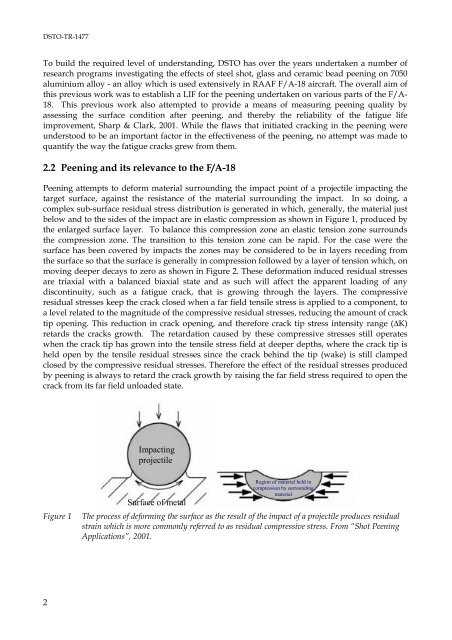Fatigue Crack Growth in 7050T7451 Aluminium Alloy Thick Section ...
Fatigue Crack Growth in 7050T7451 Aluminium Alloy Thick Section ...
Fatigue Crack Growth in 7050T7451 Aluminium Alloy Thick Section ...
Create successful ePaper yourself
Turn your PDF publications into a flip-book with our unique Google optimized e-Paper software.
DSTO-TR-1477To build the required level of understand<strong>in</strong>g, DSTO has over the years undertaken a number ofresearch programs <strong>in</strong>vestigat<strong>in</strong>g the effects of steel shot, glass and ceramic bead peen<strong>in</strong>g on 7050alum<strong>in</strong>ium alloy - an alloy which is used extensively <strong>in</strong> RAAF F/A-18 aircraft. The overall aim ofthis previous work was to establish a LIF for the peen<strong>in</strong>g undertaken on various parts of the F/A-18. This previous work also attempted to provide a means of measur<strong>in</strong>g peen<strong>in</strong>g quality byassess<strong>in</strong>g the surface condition after peen<strong>in</strong>g, and thereby the reliability of the fatigue lifeimprovement, Sharp & Clark, 2001. While the flaws that <strong>in</strong>itiated crack<strong>in</strong>g <strong>in</strong> the peen<strong>in</strong>g wereunderstood to be an important factor <strong>in</strong> the effectiveness of the peen<strong>in</strong>g, no attempt was made toquantify the way the fatigue cracks grew from them.2.2 Peen<strong>in</strong>g and its relevance to the F/A-18Peen<strong>in</strong>g attempts to deform material surround<strong>in</strong>g the impact po<strong>in</strong>t of a projectile impact<strong>in</strong>g thetarget surface, aga<strong>in</strong>st the resistance of the material surround<strong>in</strong>g the impact. In so do<strong>in</strong>g, acomplex sub-surface residual stress distribution is generated <strong>in</strong> which, generally, the material justbelow and to the sides of the impact are <strong>in</strong> elastic compression as shown <strong>in</strong> Figure 1, produced bythe enlarged surface layer. To balance this compression zone an elastic tension zone surroundsthe compression zone. The transition to this tension zone can be rapid. For the case were thesurface has been covered by impacts the zones may be considered to be <strong>in</strong> layers reced<strong>in</strong>g fromthe surface so that the surface is generally <strong>in</strong> compression followed by a layer of tension which, onmov<strong>in</strong>g deeper decays to zero as shown <strong>in</strong> Figure 2. These deformation <strong>in</strong>duced residual stressesare triaxial with a balanced biaxial state and as such will affect the apparent load<strong>in</strong>g of anydiscont<strong>in</strong>uity, such as a fatigue crack, that is grow<strong>in</strong>g through the layers. The compressiveresidual stresses keep the crack closed when a far field tensile stress is applied to a component, toa level related to the magnitude of the compressive residual stresses, reduc<strong>in</strong>g the amount of cracktip open<strong>in</strong>g. This reduction <strong>in</strong> crack open<strong>in</strong>g, and therefore crack tip stress <strong>in</strong>tensity range (∆K)retards the cracks growth. The retardation caused by these compressive stresses still operateswhen the crack tip has grown <strong>in</strong>to the tensile stress field at deeper depths, where the crack tip isheld open by the tensile residual stresses s<strong>in</strong>ce the crack beh<strong>in</strong>d the tip (wake) is still clampedclosed by the compressive residual stresses. Therefore the effect of the residual stresses producedby peen<strong>in</strong>g is always to retard the crack growth by rais<strong>in</strong>g the far field stress required to open thecrack from its far field unloaded state.Impact<strong>in</strong>gprojectileFigure 1Surface of metalRegion of material held <strong>in</strong>compression by surround<strong>in</strong>gmaterialThe process of deform<strong>in</strong>g the surface as the result of the impact of a projectile produces residualstra<strong>in</strong> which is more commonly referred to as residual compressive stress. From “Shot Peen<strong>in</strong>gApplications”, 2001.2
















